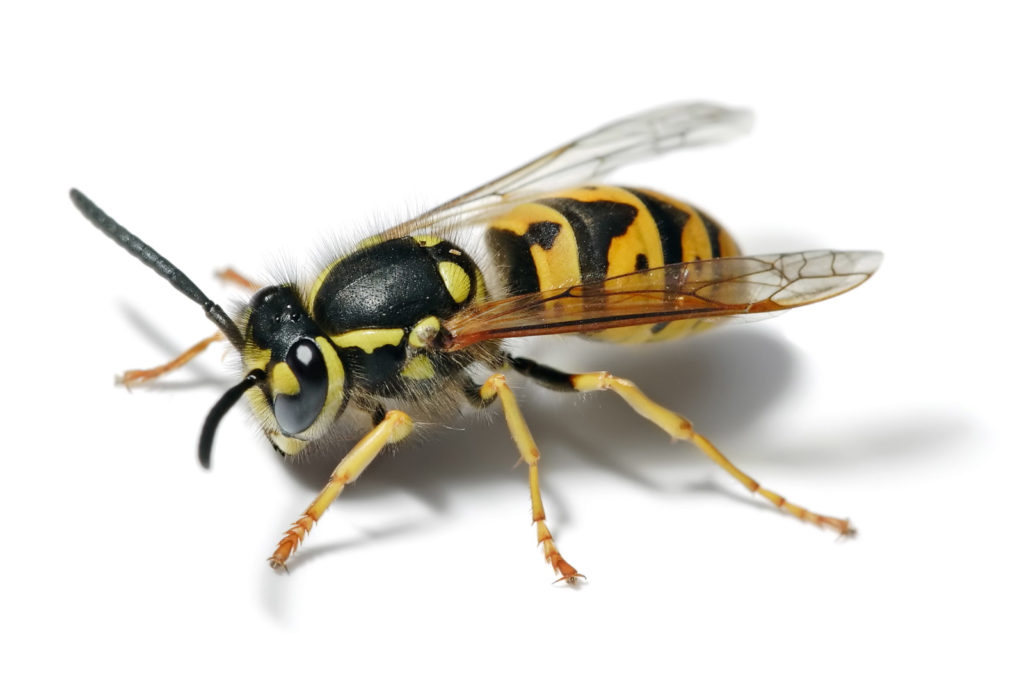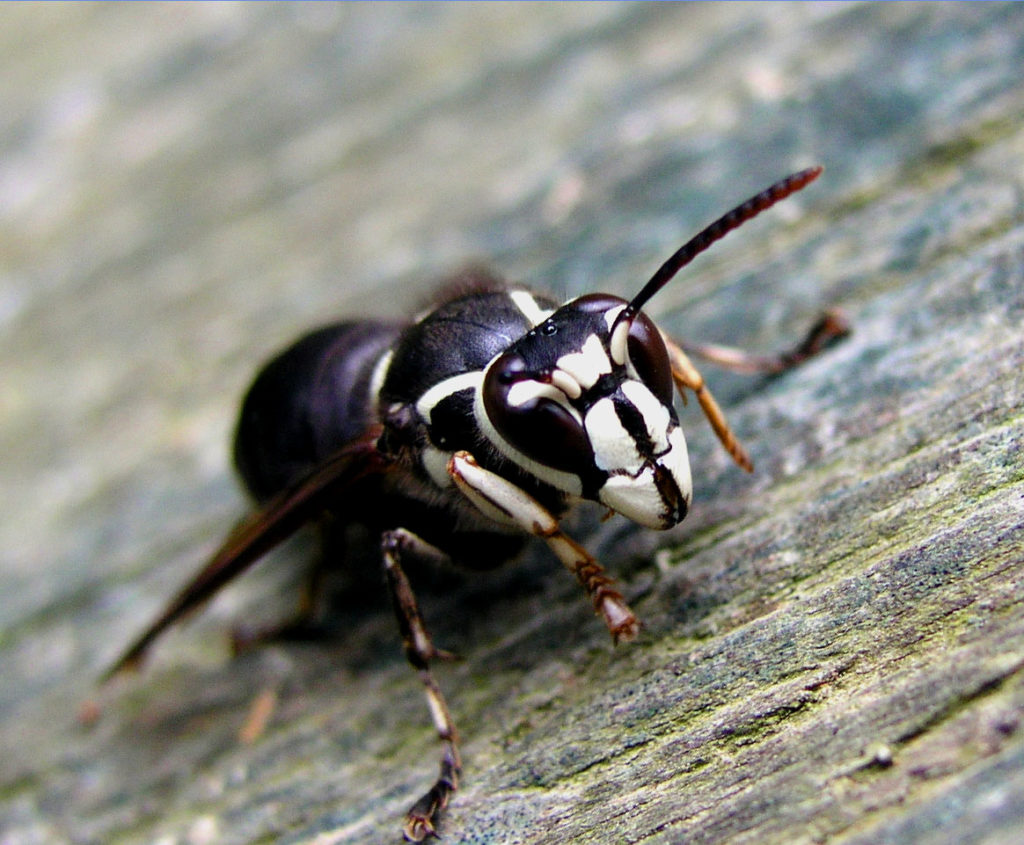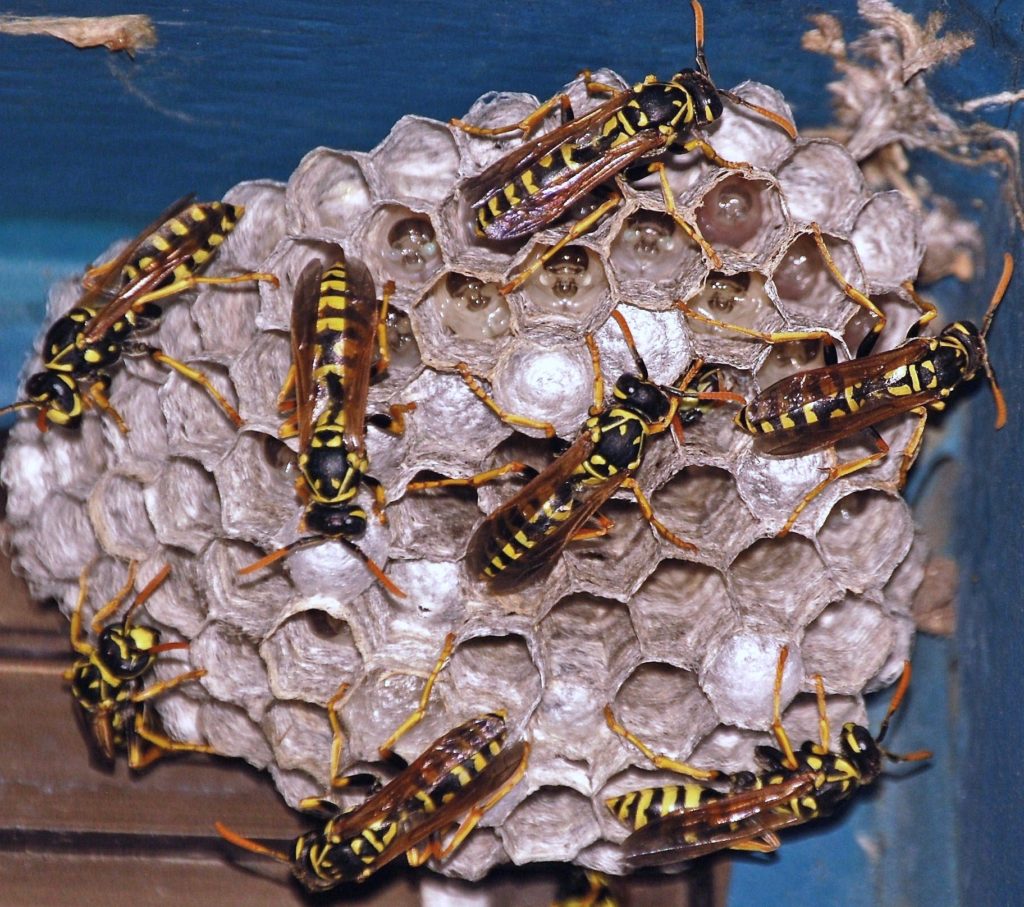
YellowJacket
Yellowjacket or Yellow jacket is the common name in North America for predatory social wasps of the genera Vespula and Dolichovespula . Members of these genera are known simply as "wasps" in other English-speaking countries. Most of these are black and yellow like the eastern yellowjacket Vespula maculifrons and the aerial yellowjacket Dolichovespula arenaria; some are black and white like the bald-face hornet, Dolichovespula maculata. Others may have the abdomen background color red instead of black. They can be identified by their distinctive markings, their occurrence only in colonies, and a characteristic, rapid, side-to-side flight pattern prior to landing. All females are capable of stinging. Yellowjackets are important predators of pest insects.
Yellowjackets are sometimes mistakenly called “bees” (as in "meat bees"), given that they are similar in size and sting, but yellowjackets are actually wasps. They may be confused with other wasps, such as hornets and paper wasps. Polistes dominula, a species of paper wasp, is very frequently misidentified as a yellowjacket. A typical yellowjacket worker is about 12 mm (0.5 in) long, with alternating bands on the abdomen; the queen is larger, about 19 mm (0.75 in) long (the different patterns on their abdomens help separate various species). Workers are sometimes confused with honey bees, especially when flying in and out of their nests. Yellowjackets, in contrast to honey bees, have yellow or white markings, are not covered with tan-brown dense hair on their bodies, do not carry pollen, and do not have the flattened hairy hind legs used to carry it.

YellowJacket
Yellowjacket or Yellow jacket is the common name in North America for predatory social wasps of the genera Vespula and Dolichovespula . Members of these genera are known simply as "wasps" in other English-speaking countries. Most of these are black and yellow like the eastern yellowjacket Vespula maculifrons and the aerial yellowjacket Dolichovespula arenaria; some are black and white like the bald-face hornet, Dolichovespula maculata. Others may have the abdomen background color red instead of black. They can be identified by their distinctive markings, their occurrence only in colonies, and a characteristic, rapid, side-to-side flight pattern prior to landing. All females are capable of stinging. Yellowjackets are important predators of pest insects.
Yellowjackets are sometimes mistakenly called “bees” (as in "meat bees"), given that they are similar in size and sting, but yellowjackets are actually wasps. They may be confused with other wasps, such as hornets and paper wasps. Polistes dominula, a species of paper wasp, is very frequently misidentified as a yellowjacket. A typical yellowjacket worker is about 12 mm (0.5 in) long, with alternating bands on the abdomen; the queen is larger, about 19 mm (0.75 in) long (the different patterns on their abdomens help separate various species). Workers are sometimes confused with honey bees, especially when flying in and out of their nests. Yellowjackets, in contrast to honey bees, have yellow or white markings, are not covered with tan-brown dense hair on their bodies, do not carry pollen, and do not have the flattened hairy hind legs used to carry it.
Baldface Hornet
Dolichovespula maculata is a eusocial wasp of the cosmopolitan family Vespidae. Its colloquial names include the bald-faced hornet, bald hornet, white-faced hornet, white-tailed hornet, spruce wasp, blackjacket, and bull wasp. This species is a yellowjacket wasp, not a true hornet (genus Vespa). Colonies contain 400 to 700 workers, the largest recorded colony size in its genus, Dolichovespula. It builds a characteristic large hanging paper nest up to 58 centimetres (23 in) in length. Workers aggressively defend their nest by repeatedly stinging invaders. Dolichovespula maculata is distributed throughout the United States and southern Canada, but is most common in the southeastern United States. Males in this species are haploid and females are diploid. Worker females can therefore lay eggs which develop into males. Matricide might occur after sufficient workers have been raised and queen-destined eggs have been laid, in order to give workers a reproductive advantage. Baldfaced hornets are distinguished from other yellowjackets by their white and black coloring. It has a white or "baldfaced" head, which is the source of its colloquial namesake. These wasps also have three white stripes at the end of their bodies. They are notably larger than other species of Dolichovespula, as adults average about 19 millimetres (0.75 in) in length. Queen and worker wasps have similar morphologies. However, workers are covered by small hairs while the queen remains hairless. Queens are always larger than workers in their colonies, though size distributions can vary in different nests and workers in one colony might be as large as a queen in a different one. D. maculata create egg-shaped, paper nests up to 360 millimetres (14 in) in diameter and 580 millimetres (23 in) in length. Nests are layered hexagonal combs covered by a mottled gray paper envelope. Bald-faced Hornets create this paper envelope by collecting and chewing naturally occurring fibers. The wood fiber mixes with their saliva to become a pulpy substance that they can then form into place.


Baldface Hornet
Dolichovespula maculata is a eusocial wasp of the cosmopolitan family Vespidae. Its colloquial names include the bald-faced hornet, bald hornet, white-faced hornet, white-tailed hornet, spruce wasp, blackjacket, and bull wasp. This species is a yellowjacket wasp, not a true hornet (genus Vespa). Colonies contain 400 to 700 workers, the largest recorded colony size in its genus, Dolichovespula. It builds a characteristic large hanging paper nest up to 58 centimetres (23 in) in length. Workers aggressively defend their nest by repeatedly stinging invaders. Dolichovespula maculata is distributed throughout the United States and southern Canada, but is most common in the southeastern United States. Males in this species are haploid and females are diploid. Worker females can therefore lay eggs which develop into males. Matricide might occur after sufficient workers have been raised and queen-destined eggs have been laid, in order to give workers a reproductive advantage. Baldfaced hornets are distinguished from other yellowjackets by their white and black coloring. It has a white or "baldfaced" head, which is the source of its colloquial namesake. These wasps also have three white stripes at the end of their bodies. They are notably larger than other species of Dolichovespula, as adults average about 19 millimetres (0.75 in) in length. Queen and worker wasps have similar morphologies. However, workers are covered by small hairs while the queen remains hairless. Queens are always larger than workers in their colonies, though size distributions can vary in different nests and workers in one colony might be as large as a queen in a different one. D. maculata create egg-shaped, paper nests up to 360 millimetres (14 in) in diameter and 580 millimetres (23 in) in length. Nests are layered hexagonal combs covered by a mottled gray paper envelope. Bald-faced Hornets create this paper envelope by collecting and chewing naturally occurring fibers. The wood fiber mixes with their saliva to become a pulpy substance that they can then form into place.

Wasp
A wasp is any insect of the order Hymenoptera and suborder Apocrita that is neither a bee nor an ant. The Apocrita have a common evolutionary ancestor and form a clade; wasps as a group do not form a clade, but are paraphyletic with respect to bees and ants. The most commonly known wasps, such as yellowjackets and hornets, are in the family Vespidae and are eusocial, living together in a nest with an egg-laying queen and non-reproducing workers. Eusociality is favoured by the unusual haplodiploid system of sex determination in Hymenoptera, as it makes sisters exceptionally closely related to each other. However, the majority of wasp species are solitary, with each adult female living and breeding independently. Many of the solitary wasps are parasitoidal, meaning that they raise their young by laying eggs on or in other insects (any life stage from egg to adult). Unlike true parasites, the wasp larvae eventually kill their hosts. Solitary wasps parasitize almost every pest insect, making wasps valuable in horticulture for biological pest control of species such as whitefly in tomatoes and other crops. Wasps play many ecological roles. Some are predators, whether to feed themselves or to provision their nests. Many, notably the cuckoo wasps, are kleptoparasites, laying eggs in the nests of other wasps. Wasps have appeared in literature from Classical times, as the eponymous chorus of old men in Aristophanes 422 BC comedy Σφῆκες (Sphēkes), The Wasps, and in science fiction from H.G. Well’s 1904 novel The Food of the Gods and How It Came to Earth, featuring giant wasps with three-inch-long stings. The name "Wasp" has been used for many warships and other military equipment.
Treatment and nest removal
Call or email us for service
Treatment and nest removal
Call or email us for service